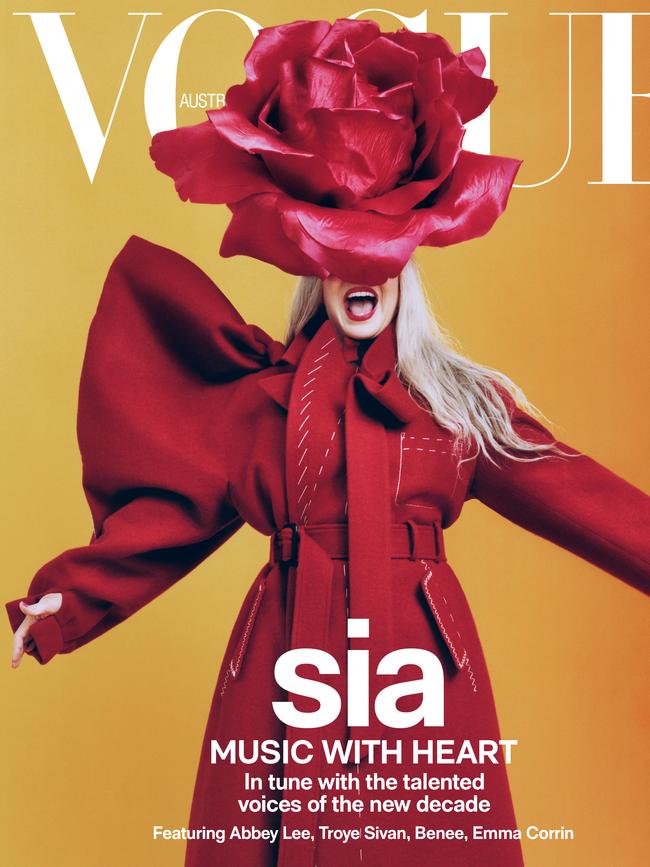Sia the ‘savant’ on her PTSD, drugs, sobriety and divorce
In a tell-all interview, the global pop sensation from Adelaide reveals her rare musical gift, why she adopted two 18-year-olds and how making a film post-divorce was like “jumping off a cliff”.

She is the woman behind some of the world’s most popular songs who (almost) never shows her face. Now Sia has revealed the inner workings of her brilliant mind, along with a litany of ongoing health problems and the painful story behind her latest work.
Sia, who wrote Rhianna’s Diamonds and David Guetta’s Titanium, doesn’t process audio like the rest of us, she says. Indeed, after working non-stop editing a new film, she has been diagnosed as a ‘savant’. “I think it might be that it’s a technical sport and I’m not a technical athlete. [It was] discovered that I’m a musical savant, which means all the audio filtering processes are different in my brain to everybody else’s brain,” she told Vogue Australia in a cover story interview this month which accompanied her first fashion shoot in five years.
“But what that gift – or curse – can also mean is I can have some parts of my brain, which are receiving a lot less energy.
“The neutrons aren’t meeting the places that get to the neural pathways like carrying them all the way, the train to the station …
“I was pulling my hair out after a year of editing and I just had to walk away.”
The artist is about to release her first film, Music, a project she started on after the split from her husband Erik Anders Lang in 2016.
“I guess it was like jumping off a cliff, but it was definitely a baptism by fire. It isn’t much different from making a music video except that it’s so much harder because of continuity and availability of actors that I can’t even believe one movie ever got made! You know, you only need between one and five people to make a song,” she explains.

However, it was her perfectionism that led to the artist’s eventual reckoning. A producer for the film stepped in, checking on her progress once a month after the editing process came and she “literally felt suicidal”.
“It made me sick. I actually couldn’t get out of bed,” she continues. “Basically that’s why it took four years to come out [after filming] because I wouldn’t put out anything unless I thought it was exceptional. I decided, like, that was the word that I’ve ruined myself with.”
“As soon as I said that, I was like: ‘Oh, you’re fucked.’”
Now, Sia is more or less in control of her mental health — although recurring PTSD still inhibits her. It’s something she’s eager to discuss, however, to set a better example for those who follow. “When I first started working with a trauma therapist five years ago I was what is known as complexly disorganised, what used to be known as complexly fearful avoidant, so I have complex PTSD from a number of incidences throughout my life and some reoccurring ones during my childhood. I figure, if we don’t talk about it,” she pauses to reframe, “we are just the same as everyone else and maybe our brains work a little differently.
“But if we’re interesting [enough] to be on a podcast or on the cover of a magazine then I certainly think it is our duty to be honest about who we are and where our heads are at because selling a dream is negligent.
“If you ask eight children out of 10 today what they want to be when they grow up they say ‘famous’, and that is terrifying. They believe that will solve their problems, and I did too. I thought when I got famous I would not be mentally ill.”
She adds: “I created this whoop-dee-doo indie-pop character I could no longer maintain after 15 years in the industry and I completely had a nervous breakdown and started using drugs and eventually became sober.
Still today, she’s no short on “problems”, having been diagnosed with a slew of conditions, including Ehlers-Danlos syndrome, Complex Regional Pain Syndrome and Cubital Tunnel Syndrome, which cause her chronic limb and joint pain as well as fatigue. As she jokes, she’s ready to retire: “my body has done enough for 500 years”.
Last year, Sia took a serious maternal leap last year when she adopted two 18-year-old sons seemingly out of nowhere.
Explaining how it came about, she reveals: “I am obsessed with reality television and documentaries, and I watched a documentary and saw my son. I was like: ‘What? Like, he doesn’t have anybody. Oh my god. I’m going to find him and I’m going to be his mummy.’ And so that’s what I did.” She says by the time she tracked him down he was 18 and ageing out of the foster system so it was considered an adult adoption. “He asked if he could bring his friend and I said: ‘Well, yes, I’ve got two bedrooms so why not?’”
Read the full interview in the October issue of Vogue Australia

To join the conversation, please log in. Don't have an account? Register
Join the conversation, you are commenting as Logout